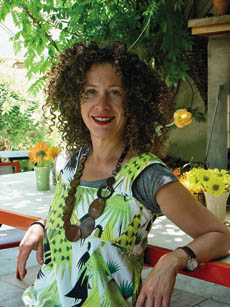Chef Nancy Silverton Offers Quick Meals from Jars, Cans, and Boxes
Cupboard Cooking

It’s hard to imagine Southern California’s current culinary landscape without Nancy Silverton. She created La Brea Bakery, which taught us bread could be a thing of wonder and not just Wonder Bread. (In 2001, Silverton and partners Mark Peel and Manfred Krankl sold an 80 percent stake in the bakery to the Irish company IAWS Group for $68.5 million, so she knows how to raise all kinds of dough.) Silverton codeveloped Campanile in Los Angeles with Peel and Krankl, not only opening one of the signature restaurants for California-style, farmers-market driven food, but also creating a training ground for some of the best chefs in L.A., including Suzanne Tracht at Jar, Suzanne Goin of Lucques and A.O.C., and Chris Kidder and Kimberly Sklar of Literati II. With ¼ber-chef Mario Batali, Silverton opened Pizzeria Mozza last fall-home of the best pizza on the planet; really, this woman knows her yeasty products-and any day now, she will open the eagerly anticipated Osteria Mozza next door. She’s even an investor in Santa Barbara’s own recent shining star, The Hungry Cat.
So, it might come as a surprise to some that her latest cookbook suggests we should all attempt “quick, flavorful meals with ingredients from jars, cans, bags, and boxes.” Indeed that’s the subtitle of the clever A Twist of the Wrist she wrote with Carolynn Carre±o. Silverton kindly agreed to a phone interview recently, despite having just left the dentist office prior to our chat.
“I really respect the Alice Waters of the world who probably don’t even own a can opener,” she said, “but then there are the people who make only Kraft Macaroni & Cheese. I’m looking for the happy medium with this book, trying to get people to find pleasure in the kitchen,” Silverton said. “Even the popular magazines like Bon Appetit and Gourmet have big sections for those too busy to cook.”
The process of creating the book, she said, “meant doing a whole lot of shopping and going to a whole lot of stores-Whole Foods, Trader Joe’s, John’s [an ethnic food chain in L.A.]. I would look at ingredients very carefully so there would be no preservatives, no artificial ingredients, no ingredients I couldn’t pronounce.”
Alas, trying to find these ingredients even in relatively food-savvy Santa Barbara hasn’t been easy; the time saved by the quick, mostly fewer-than-30-minute recipes is often lost in the hunt for the unusual, crucial jar. For instance, Lazy Acres carries one of the Patak’s brand sauces, but for the full line, you have to head to the Indo-China Market (6831 Hollister Ave., Goleta). If you want to hunt down more Eastern European products, like Bende mixed salad, a kind of sauerkraut-plus from Hungary, go to the International Deli and Market (4422 Hollister Ave., Goleta). It’s hard to imagine what folks in Sioux City or Cheyenne do when confronted with the search for these ingredients (beyond curse those of us who eat better on the coasts).
It gets even more complicated because one type of food from a purveyor does not mean all of that company’s products get the Silverton seal of approval. “I read an article on Thomas Keller [chef at the acclaimed The French Laundry and Per Se], and he said he ate Progresso’s lentil soup after work when he came home. It turns out all the ingredients are natural. But then I looked at the rest of the line, like some sort of collard greens, and many are full of MSG, so I didn’t use any others in my book.”
The same thing happened when she looked into soup recipes for the book. She asserted, “The Imagine line, their corn and their tomato and roasted pepper are quite good, but a few were just plain awful-the mushroom and broccoli.” As for how she gussies up the soups, she said, “I didn’t want to have people just open it up and heat it up. The corn has a bacon-and-cheddar crostini and the tomato has a pesto crouton. Both add a level of complexity to a dish to personalize it.”
Despite her drive to be sure that recipes provided “something more sophisticated than you’d think” could come from packaged products, Silverton couldn’t escape including the generally plebian Best Food’s mayonnaise. “Whenever possible I try to use organic products-it’s really wonderful to educate the public,” she said. “But I couldn’t come up with a flavor of mayonnaise that reminded me of Best Foods. It would be a little off, either too sweet or whatever.”
What wasn’t off was her attempt to bring in recipes from other chefs, including many of those who had worked with her at Campanile. (Tracht offers up her chopped sirloin on toast topped with a fried egg and green peppercorn sauce, while Goin provides her take on Chasen’s Famous Chili.) It seems the top chefs aren’t shy about making something out of seemingly nothing. “I had a lot more responses than I could put in the book,” Silverton said. Those include items like Seattle superstar Tom Douglas explaining how to make Costco pot stickers into a delightful meal (our test kitchen liked the dumplings but says jazz up the vegetable accompaniment a bit) and Jimmy Shaw of Loter-a Grill in L.A. coming up with a mole poblano chicken casserole with black beans and queso fresco that not only doctors bottled mole sauce, but also uses store-cooked rotisserie chicken. (About that, Silverton said, “It’s worth the effort to find a good local source. Is a Whole Foods chicken better than a Costco chicken? I don’t know, but I would say so.”)
Ultimately, though, it’s hard to deny a woman who says her book “is an invitation and ‘permission’ to open a jar. It is an invitation to think in a totally different way about cooking. : And it is my invitation to you to get back in the kitchen.”



